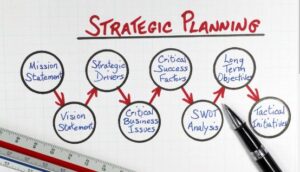By Patrick Cahillane – Life, Executive & Business Coach with One Source International Coaching & Training and Founder of The One Source Personal Development Network

As a business owner, it’s essential to have a long-term vision for your business, set achievable goals, and develop a roadmap for achieving success. This process is called strategic planning, and it’s critical to your business’s success. Strategic planning is a process that helps a business to define its direction and make decisions on allocating its resources to pursue this direction. This blog post will discuss the importance of strategic planning and provide tips on how to create a long-term vision for your business, set achievable goals, and develop a roadmap for achieving success.
Why is Strategic Planning Important?
Strategic planning is essential because it helps you to define the direction of your business and align your goals with your vision. A well-executed strategic plan can help you to identify your strengths and weaknesses, opportunities, and threats in your business environment. It also helps you to develop a roadmap for achieving your long-term goals, which is critical for any business’s success.
How to Create a Long-term Vision for Your Business?
Creating a long-term vision for your business is the first step in strategic planning. A long-term vision is a statement of what you want to achieve in the future. To create a long-term vision, you need to ask yourself some critical questions about your business. What is the purpose of your business? What are your core values? What do you want your business to achieve in the next five or ten years? Your answers to these questions will help you to define your long-term vision.
Set Achievable Goals
Once you have a long-term vision for your business, the next step is to set achievable goals. Goals are specific, measurable, and time-bound targets that you want to achieve to move your business forward. Setting achievable goals is critical for any business because it helps you to stay focused and motivated. To set achievable goals, you need to break down your long-term vision into smaller, more manageable goals. You can use the SMART criteria to set your goals. SMART stands for Specific, Measurable, Achievable, Relevant, and Time-bound.
Develop a Roadmap for Achieving Success
The final step in strategic planning is to develop a roadmap for achieving success. A roadmap is a detailed plan that outlines the steps you need to take to achieve your goals. To develop a roadmap, you need to identify the resources you need, including people, technology, and finances, to achieve your goals. You also need to identify potential challenges that may hinder your progress and develop strategies to overcome them.
Tips for Successful Strategic Planning
- Involve your team: Strategic planning should involve your entire team, not just the business owner. This ensures that everyone understands the business’s direction and is committed to achieving the set goals.
- Review and update your plan regularly: Strategic planning is an ongoing process that requires regular reviews and updates. This helps you to track your progress and make necessary adjustments to ensure you stay on course.
- Be flexible: It’s essential to be flexible in your strategic planning process. Sometimes unexpected events can happen, which require you to adjust your plan to accommodate new opportunities or threats.
- Seek outside help: Strategic planning can be a complex process, and sometimes it’s helpful to seek outside help from experts. This can provide fresh perspectives and insights that can help you to develop a more effective plan.
Conclusion
In conclusion, strategic planning is critical to any business’s success. It helps you to define your long-term vision, set achievable goals, and develop a roadmap for achieving success. Strategic planning requires ongoing reviews and updates to ensure you stay on course and remain flexible to adapt to unexpected changes. By following these tips, you can create a successful strategic plan that helps you achieve your business’s long-term goals.
